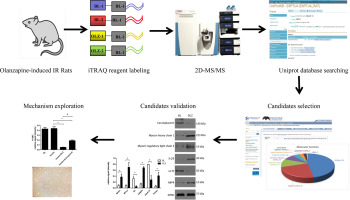当前位置:
X-MOL 学术
›
J. Proteomics
›
论文详情
Our official English website, www.x-mol.net, welcomes your
feedback! (Note: you will need to create a separate account there.)
Identification and characterization of proteins that are differentially expressed in adipose tissue of olanzapine-induced insulin resistance rat by iTRAQ quantitative proteomics.
Journal of Proteomics ( IF 2.8 ) Pub Date : 2019-11-09 , DOI: 10.1016/j.jprot.2019.103570 Ni Yang 1 , Liangyu Yu 1 , Yahui Deng 1 , Qiangqiang Han 2 , Jing Wang 1 , Lixiu Yu 1 , Zhongfang Zhai 3 , Weiyong Li 1
Journal of Proteomics ( IF 2.8 ) Pub Date : 2019-11-09 , DOI: 10.1016/j.jprot.2019.103570 Ni Yang 1 , Liangyu Yu 1 , Yahui Deng 1 , Qiangqiang Han 2 , Jing Wang 1 , Lixiu Yu 1 , Zhongfang Zhai 3 , Weiyong Li 1
Affiliation

|
Olanzapine is commonly used to treat schizophrenia. However, long-term administration of olanzapine causes metabolic side effects, such as insulin resistance (IR), which seriously affects patients' quality of life. Both diagnostic and prognostic markers are urgently needed to increase patient compliance. We applied isobaric tags for relative and absolute quantitation (iTRAQ) labeling combined with 2D LC/MS/MS technology to identify the differentially expressed proteins in olanzapine-induced IR rats. A total of 3194 proteins were identified from rat adipose tissues, and 270 differentially expressed proteins were screened out with a ratio threshold >1.5-fold or <0.67-fold. Based on a bioinformatics analysis and literature search, we selected six candidates (MYH1, MYL2, Cp, FABP4, apoA-IV, and Ywhaz) from a set of 270 proteins and verified these proteins by western blot; the expression of these proteins coincided with the LC-MS/MS results. Finally, the biological roles of FABP4 and apoA-IV, which are two novel IR-related proteins identified in the present study, were verified in 3T3-L1 cells. These data suggest that these two proteins acted on olanzapine-induced IR via the IRS-1/AKT signaling pathway. Our results provide a dataset of potential targets to explore the mechanism in olanzapine-induced IR and reveal the new roles of FABP4 and apoA-IV in olanzapine-induced IR. SIGNIFICANCE: The proteomic analysis of this study revealed the target associated with olanzapine-induced IR and provided relevant insights into the molecular functions, biological processes, and signaling pathways in these targets. Protein MYH1, MYL2, Cp, FABP4, apoA-IV, and Ywhaz may be potential biomarkers, and protein FABP4 and apoA-IV were considered as promising targets in olanzapineinduced IR. Therefore, if the performance of the proposed biomarkers is further confirmed, these proteins can provide powerful targets for exploring the mechanism of olanzapine-induced IR.
中文翻译:

通过iTRAQ定量蛋白质组学鉴定和表征在奥氮平诱导的胰岛素抵抗大鼠的脂肪组织中差异表达的蛋白质。
奥氮平常用于治疗精神分裂症。但是,长期服用奥氮平会引起代谢副作用,例如胰岛素抵抗(IR),严重影响患者的生活质量。迫切需要诊断和预后指标,以增加患者的依从性。我们将等压标记用于相对和绝对定量(iTRAQ)标记,并结合2D LC / MS / MS技术来鉴定奥氮平诱导的IR大鼠中差异表达的蛋白质。从大鼠脂肪组织中总共鉴定出3194种蛋白质,并筛选出270种差异表达的蛋白质,比率阈值> 1.5倍或<0.67倍。根据生物信息学分析和文献搜索,我们选择了六个候选对象(MYH1,MYL2,Cp,FABP4,apoA-IV,和Ywhaz)收集了270种蛋白质,并通过Western blot验证了这些蛋白质;这些蛋白质的表达与LC-MS / MS结果一致。最后,在3T3-L1细胞中验证了FABP4和apoA-IV的生物学作用,这是本研究中鉴定的两个新的IR相关蛋白。这些数据表明这两种蛋白通过IRS-1 / AKT信号通路对奥氮平诱导的IR起作用。我们的结果提供了潜在目标的数据集,以探索奥氮平诱导的IR中的机制,并揭示了FABP4和apoA-IV在奥氮平诱导的IR中的新作用。意义:这项蛋白质组学分析揭示了与奥氮平诱导的IR相关的靶标,并提供了有关这些靶标中的分子功能,生物学过程和信号传导途径的相关见解。蛋白质MYH1,MYL2,Cp,FABP4,apoA-IV和Ywhaz可能是潜在的生物标志物,蛋白FABP4和apoA-IV被认为是奥氮平诱发的IR的有希望的靶标。因此,如果进一步证实了提出的生物标志物的性能,这些蛋白可以为探索奥氮平诱导的IR机制提供有力的靶标。
更新日期:2019-11-11
中文翻译:

通过iTRAQ定量蛋白质组学鉴定和表征在奥氮平诱导的胰岛素抵抗大鼠的脂肪组织中差异表达的蛋白质。
奥氮平常用于治疗精神分裂症。但是,长期服用奥氮平会引起代谢副作用,例如胰岛素抵抗(IR),严重影响患者的生活质量。迫切需要诊断和预后指标,以增加患者的依从性。我们将等压标记用于相对和绝对定量(iTRAQ)标记,并结合2D LC / MS / MS技术来鉴定奥氮平诱导的IR大鼠中差异表达的蛋白质。从大鼠脂肪组织中总共鉴定出3194种蛋白质,并筛选出270种差异表达的蛋白质,比率阈值> 1.5倍或<0.67倍。根据生物信息学分析和文献搜索,我们选择了六个候选对象(MYH1,MYL2,Cp,FABP4,apoA-IV,和Ywhaz)收集了270种蛋白质,并通过Western blot验证了这些蛋白质;这些蛋白质的表达与LC-MS / MS结果一致。最后,在3T3-L1细胞中验证了FABP4和apoA-IV的生物学作用,这是本研究中鉴定的两个新的IR相关蛋白。这些数据表明这两种蛋白通过IRS-1 / AKT信号通路对奥氮平诱导的IR起作用。我们的结果提供了潜在目标的数据集,以探索奥氮平诱导的IR中的机制,并揭示了FABP4和apoA-IV在奥氮平诱导的IR中的新作用。意义:这项蛋白质组学分析揭示了与奥氮平诱导的IR相关的靶标,并提供了有关这些靶标中的分子功能,生物学过程和信号传导途径的相关见解。蛋白质MYH1,MYL2,Cp,FABP4,apoA-IV和Ywhaz可能是潜在的生物标志物,蛋白FABP4和apoA-IV被认为是奥氮平诱发的IR的有希望的靶标。因此,如果进一步证实了提出的生物标志物的性能,这些蛋白可以为探索奥氮平诱导的IR机制提供有力的靶标。











































 京公网安备 11010802027423号
京公网安备 11010802027423号